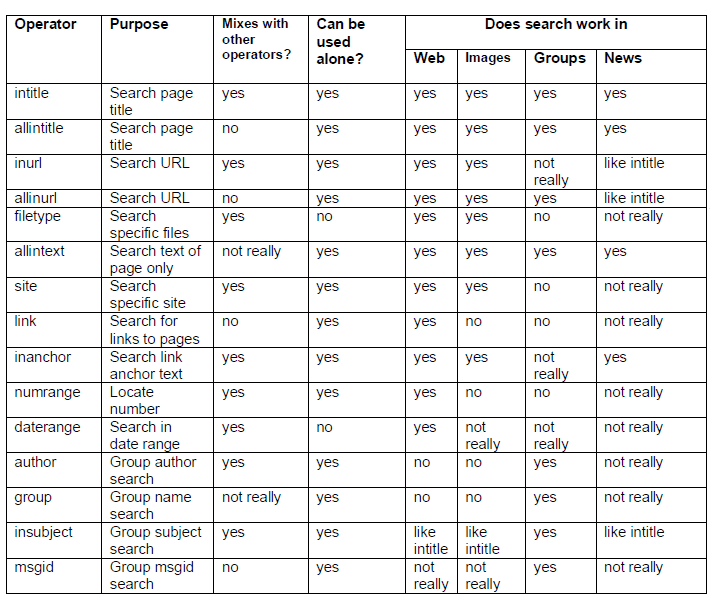


Does this mean Google uses the lower case version or the symbol version? If you picked the symbol version, congratulations! For “NOT”, Google only recognizes the minus sign (“-“) to exclude words or quotes-enclosed phrases and it must be placed directly in front of the word or phrase without a space. However, Google’s version of “NOT” is not the standard upper case. It does recognizes “OR,” but not “or.” The reason? If a lower case “or” is used it assumes the word not an operator, but part of a phrase (for example, “to be or not to be”). Google recognizes “and” and “AND.” Also, if more than one word or phrase is entered into a search, it uses “AND” as the “unwritten” default to combine the ideas (for example, if you typed Buckingham Palace without quotes it assumes Buckingham AND Palace). I was shocked to learn this when I took the Power Searching with Google class! Might that be why some of my past Google Searches were unproductive? It was. Google does not use all the standard Boolean Operators. Now imagine if the world’s largest and most popular search engine doesn’t follow standard Boolean operators. It is only when someone knows differently that they can use the correct variation for a particular database or website.

Why? With almost everyone I observed at the reference desk–both patrons and the other librarians on duty–one normally defaults to using the lower case due to typing simplicity (usually, lower case does work in popular databases). However, most of the time these variations, when they occur, are not obvious and cause searches to be hampered because the operators will not work properly. Occasionally, you can find them in a sidebar on the advanced search menu. These variations can usually be located under the “Help” menu. Some might even recognize multiple variants. Still others might use symbols instead of words (ex. Others use upper case letters (the original version of Boolean was all upper case). Some require the letters all be lower case. What the non-librarians may not know is that databases sometimes vary how Boolean operators are used. These skills are not only useful when locating data, but are often the first information literacy skills taught to patrons, especially in K-12 schools and higher education. While not Boolean, enclosing phrases in quotations marks (” “) means the searcher is looking for an exact phrase instead of those two words anywhere in the document. Just to recap, “AND” combines terms to limit a search (ex.
Google boolean search exclude words how to#
Knowing how to use “AND,” “OR,” and “NOT” are keys to searching digital data. Want more definitions? See our complete library of HR Terms.Every librarian knows their Boolean Operators. If you want to gain a thorough understanding of X-Ray search techniques to craft your own Boolean search strings, read our tutorial on Boolean search for recruitersĪlso, visit our library of Boolean search cheatsheets. Search for an exact phrase (Consider keywords in quotation marks as a whole word) Group multiple search strings and set priorities Results include either keyword or all of themĮxcludes a keyword from your search (Mention without a space before the unwanted term) Results include all keywords linked with AND To better understand the basic Boolean commands and symbols and build your own Google search string, see the table below: With the inclusion of the minus sign, you exclude sample resumes and job ads which will give you irrelevant results. This search string detects all the resume or CV files (intitle:resume OR intitle:CV) that contain the word ‘physical therapist’ and mention a degree in kinesiology. (intitle:resume OR intitle:cv) “physical therapist” kinesiology (bachelor OR master OR degree) -job -jobs -sample -examples Here is a command example searching for a physical therapist with a degree in kinesiology: The Google search string should have all the essential keywords and symbols that’ll bring you accurate results. What is a search string example on Google? Academic degree and other certifications.Employees who work or have worked in a specific company.Examples of information you can find using the Google X-Ray search By putting together specific words and phrases, you can narrow down your search to a limited number of results and spot candidates with the preferable qualifications and skills. Google X-Ray is popular in recruitment, with Boolean search being a powerful tool for effective candidate sourcing. Google Boolean strings are commands that help you come up with targeted results by applying the so-called Boolean operators, for example AND, OR, and NOT (see the Table below).

What is a search string example on Google?.Examples of information you can find using the Google X-Ray search.


 0 kommentar(er)
0 kommentar(er)
